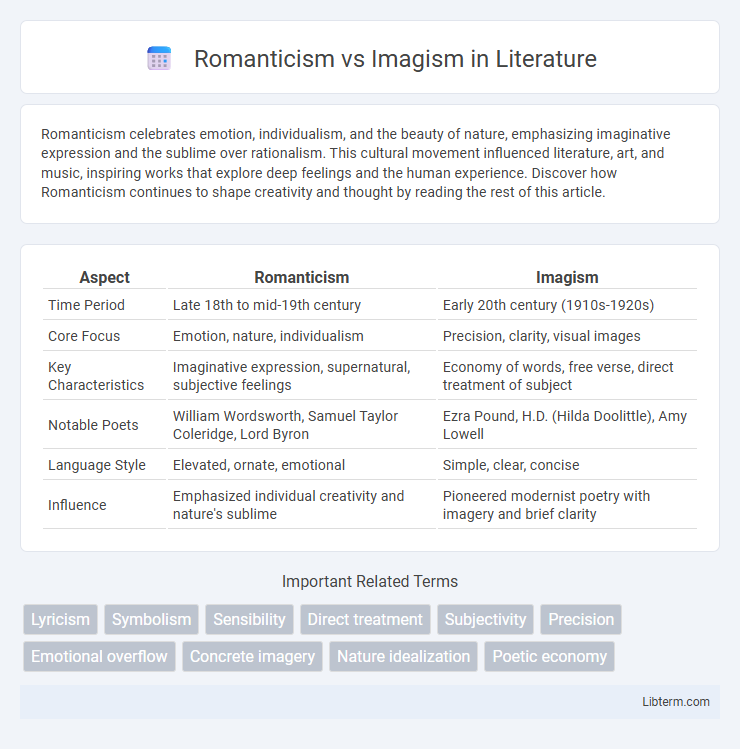Romanticism celebrates emotion, individualism, and the beauty of nature, emphasizing imaginative expression and the sublime over rationalism. This cultural movement influenced literature, art, and music, inspiring works that explore deep feelings and the human experience. Discover how Romanticism continues to shape creativity and thought by reading the rest of this article.
Table of Comparison
| Aspect | Romanticism | Imagism |
|---|---|---|
| Time Period | Late 18th to mid-19th century | Early 20th century (1910s-1920s) |
| Core Focus | Emotion, nature, individualism | Precision, clarity, visual images |
| Key Characteristics | Imaginative expression, supernatural, subjective feelings | Economy of words, free verse, direct treatment of subject |
| Notable Poets | William Wordsworth, Samuel Taylor Coleridge, Lord Byron | Ezra Pound, H.D. (Hilda Doolittle), Amy Lowell |
| Language Style | Elevated, ornate, emotional | Simple, clear, concise |
| Influence | Emphasized individual creativity and nature's sublime | Pioneered modernist poetry with imagery and brief clarity |
Introduction to Romanticism and Imagism
Romanticism, emerging in the late 18th century, emphasized emotion, nature, and individualism, often celebrating the sublime and the imagination in poetic expression. Imagism, developed in the early 20th century by poets like Ezra Pound and H.D., focused on precise, clear imagery and concise language, breaking away from the elaborate style of Romantic poetry. Both movements revolutionized poetry by prioritizing different aspects of human experience: Romanticism through emotional depth and imagination, Imagism through visual clarity and economy of words.
Historical Contexts of Romanticism and Imagism
Romanticism emerged in the late 18th century as a reaction to the Industrial Revolution and Enlightenment rationalism, emphasizing emotion, nature, and individualism. Imagism developed in the early 20th century, influenced by modernist trends and a backlash against Victorian verbosity, promoting clarity, precision, and vivid imagery. While Romanticism sought to evoke deep feeling through sweeping narratives, Imagism focused on concise, concrete visuals shaped by early 20th-century urban and technological changes.
Philosophical Foundations: Emotion vs Precision
Romanticism emphasizes the primacy of emotional experience, intuition, and individual imagination, reflecting a belief in the inherent value of subjective feelings and nature's beauty. Imagism, by contrast, prioritizes precision, clarity, and economy of language, grounded in a philosophical foundation that values direct treatment of the "thing" and exactness in visual imagery. This fundamental divergence highlights Romanticism's focus on emotional depth versus Imagism's commitment to linguistic exactitude and concrete representation.
Key Figures in Romanticism and Imagism
Key figures in Romanticism include William Wordsworth, Samuel Taylor Coleridge, and John Keats, who emphasized emotion, nature, and individualism in their poetry. Imagism, emerging in the early 20th century, was led by Ezra Pound, H.D. (Hilda Doolittle), and Amy Lowell, focusing on clarity, precision, and vivid imagery. The contrast between the two movements lies in Romanticism's elaborate emotional expression versus Imagism's concise, direct presentation of concrete images.
Literary Techniques and Styles Compared
Romanticism employs elaborate and emotive language, emphasizing nature, individualism, and the sublime through vivid imagery and metaphor, often structured in formal verse like sonnets or odes. Imagism, emerging in the early 20th century, favors concise, clear, and direct language with a focus on precise visual images, employing free verse to capture moments in sharp, unadorned detail. While Romanticism explores deep emotional expression and grand themes, Imagism prioritizes economy of words and clarity, stripping away excess to reveal the essence of the subject.
Themes Explored: Nature, Imagination, and Reality
Romanticism delves into the sublime beauty of nature, emphasizing emotional depth and the boundless power of imagination to transcend reality. Imagism, by contrast, focuses on precise, clear images that capture a moment in nature with stark realism, stripping away embellishment to reveal truth. Both movements explore nature and reality but diverge in approach: Romanticism elevates imagination and emotional experience, while Imagism prioritizes concise, direct observation.
Language Use: Lyrical vs Economical Expression
Romanticism employs rich, lyrical language characterized by elaborate imagery, emotional intensity, and ornate descriptions that evoke subjective experience. Imagism prioritizes economical expression with precise, clear, and concrete language, focusing on direct presentation of objects and moments without superfluous words. The contrast highlights Romanticism's emphasis on emotional depth versus Imagism's commitment to clarity and brevity in poetic language.
Influence on Modern and Contemporary Poetry
Romanticism, emphasizing emotion, nature, and individualism, laid the groundwork for modern poetry by inspiring focus on subjective experience and artistic imagination. Imagism, emerging in the early 20th century, revolutionized contemporary poetry with its emphasis on clarity, precision, and concrete imagery, challenging traditional forms and encouraging economy of language. Both movements significantly shaped poetic expression, with Romanticism fostering emotional depth and Imagism promoting vivid, direct presentation of ideas.
Legacy and Lasting Impact on Literature
Romanticism revolutionized literature by emphasizing emotion, individualism, and nature, inspiring subsequent movements and shaping modern poetic expression. Imagism's legacy lies in its precision, clarity, and free verse techniques, which transformed early 20th-century poetry and influenced contemporary minimalism. Both movements significantly contributed to evolving poetic forms and thematic depth, leaving enduring impacts on literary style and interpretation.
Conclusion: Contrasts and Connections
Romanticism emphasizes emotional depth, individualism, and the sublime in nature, while Imagism prioritizes clarity, precision, and economy of language through vivid imagery. Despite their differences, both movements share a commitment to breaking traditional poetic forms and exploring new expressions of experience. Their contrasts highlight evolving artistic priorities, yet their connections reveal an enduring pursuit of capturing human perception and emotion in innovative ways.
Romanticism Infographic

 libterm.com
libterm.com